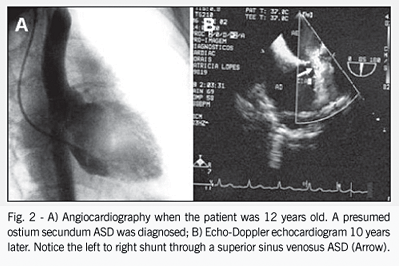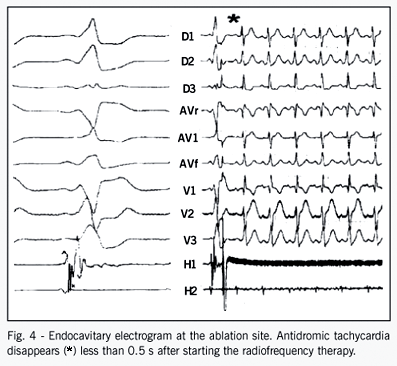Abstracts
The Wolff-Parkinson-White syndrome (WPW) and sinus venosus atrial septal defect (ASD) association is very rare and not yet reported in the literature. It is the main basis for this case report.
A associação de comunicação interatrial (CIA) tipo seio venoso com síndrome de Wolff Parkinson White (WPW) é muito rara e ainda não descrita na literatura médica especializada. Descreve-se o caso de uma jovem portadora dessa associação de patologias tratada com ablação da via acessória por radiofreqüência, seguida de correção cirúrgica do defeito do septo interatrial.
CASE REPORT
Wolff-Parkinson-White syndrome and sinus venosus atrial septal defect association
Patrícia Lopes Moraes; Luíz Márcio Gerken; Bayard Gontijo Filho; Walter Villela de Andrade Vicente; Paulo Roberto Barbosa Evora
Ribeirão Preto, SP / Belo Horizonte, MG - Brazil
CECORP - Ribeirão Preto, BIOCOR - Belo Horizonte and Medical School of Ribeirão Preto - USP
Correspondence Correspondence to Paulo Roberto B. Evora Rua Rui Barbosa, 367/15 Cep 14015-120 - Ribeirão Preto, SP, Brazil E-mail: prbevora@keynet.com.br
ABSTRACT
The Wolff-Parkinson-White syndrome (WPW) and sinus venosus atrial septal defect (ASD) association is very rare and not yet reported in the literature. It is the main basis for this case report.
One of the larger studies1 looking at the association between WPW and acquired or congenital heart disease was performed in France. WPW was diagnosed in 49 of 10,750 patients with acquired cardiac disease (0.45%) and in 24 of 3,761 patients presenting with congenital malformations. Of 1,348 cases of ASD, 5 patients had associated pre-excitation syndromes, 3 of them with right posterior pre-excitations associated with an ostium primum defect, but no patient presenting with sinus venosus ASD and WPW was found 1.
We herein report a young lady presenting with sinus venosus ASD and WPW who was staged for percutaneous radiofrequency ablation followed one month later by surgical correction of the ASD.
Case Report
The patient is a 22-year-old female student. Effort tachycardia and cyanosis of the extremities was noticed by 8 years of age. At the age of 12 years, congenital cardiopathy and cardiac arrhythmia were suspected by a pediatric cardiologist based on clinical examination and basal EKG (fig. 1). Heart catheterization and electrophysiological study were performed. The former diagnosed an ostium secundum ASD and measured the mean pulmonary artery pressure at 20 mmHg (fig. 2A). The latter was diagnostic for WPW syndrome. An anteroseptal accessory pathway with S1S1 antegrade conduction up to 270 ms was found. Orthodromic paroxysmal supraventricular tachycardia (PSVT) with an effective ventricular refractory period of 240 ms (450 bpm) could be induced (fig. 3).
Effort fatigue, dyspnea, and paroxysmal tachycardia ensued over the years. When the patient was 20 years of age, although a surface echocardiogram missed the ASD, a 1.2 x 1.0cm sinus venosus ASD, right chamber dilatation, and pulmonary artery systolic pressure at its superior limit of normality were depicted by transesophageal echocardiography (fig. 2B).
Two years later, symptoms worsened, the resting heart rate increased to 100 bpm, and dyspnea ensued with light effort. Propranolol 40 mg/day was started and the symptoms improved.
When the patient reached 23 years of age, WPW syndrome with an anteroseptal accessory pathway was evidenced by a percutaneous electrophysiological study. Concentric ventricle-atrial (VA) conduction without decrements and with a longer refractory period than the accessory pathway was demonstrated. The anomalous pathway was ablated 0.5s after starting 6 pulses of radiofrequency (fig. 4).
One month later, the sinus venosus ASD and the associated partial pulmonary anomalous venous drainage to the right atrium were both corrected while the patient was under normothermic extracorporeal circulation and anoxic arrest.
The patient has remained asymptomatic since then.
Discussion
WPW syndrome should be suspected in children with ASD and PSVT, but technical limitations related to the patient's size as well as the severity of heart failure may prevent a preoperative electrophysiological study.
Attempts to disclose echocardiographic signs of WPW have been disappointing. In one such study, 26 WPW cases were analyzed, and abnormal interventricular septal motion was found to occur with Type I WPW. Other echocardiographic abnormalities were also present in a high percentage of WPW patients but do not seem to be associated with any particular WPW type2.
In Japan, a 7-month-old, 5.3kg girl presenting with ASD and PSVT was surgically treated, the preoperative electrophysiological study not being performed due to severe heart failure. Suspecting a concealed WPW syndrome with retrograde conduction, surgeons performed the operation with the aid of intraoperative epicardial and endocardial mapping. A left-posterior accessory retrograde pathway was found and successfully cryoablated via a transeptal superior approach3.
A recent Canadian review on the subject presented the idea that as the number and mean age of patients with congenital heart disease increases over time, arrhythmia is becoming a more prevalent and important clinical problem. An increasing patient population with congenital heart disease with associated atrial or ventricular arrhythmias is presenting for repair or reoperation. Catheter-based electrophysiologic intervention has revolutionized the management of arrhythmia. It requires accurate preoperative characterization of the arrhythmia and may be safely and effectively included as an adjunct to repair of underlying structural cardiac lesions 4. Based on this perspective, a staged therapeutic strategy was selected for our patient, the electrophysiologic study and accessory pathway ablation being performed before the surgical treatment of the intracardiac defect.
A detail worthy of relative discussion about the WPW syndrome and sinus venosus ASD association is the question of its rarity. This fact has, at least, 2 explanations: a) the difficulty finding reports in the literature could indicate that the association of the 2 entities is really rare and; b) WPW syndrome can happen randomly in any cardiopathy or even without cardiopathy, and perhaps interest in clinical practice in such anomalies does not exist. But this sort of statement is broad and a matter of speculation.
The present case is particularly interesting and original because of the unusual association of WPW syndrome with another congenital heart disease. In fact, WPW is commonly related to Ebstein's anomaly, a very uncommon congenital heart defect. Other rare associations include hypertrophic cardiomyopathy, bicuspid aortic valve stenosis, patent ductus arteriosus, and scimitar Syndrome. This last association was first reported in Mexico City, and the therapeutical strategy was the same as that adopted in the present case; the percutaneous radiofrequency catheter ablation was performed before the surgical repairs5. As far as we know, based on a search of the medical literature (MEDLINE, LILACS, SCIRUS, GOOGLE, YAHOO), WPW syndrome associated with sinus venous ASD has not been reported.
References
Received for publication: 07/01/2004
Accepted for publication: 07/29/2004
- 1. Soria R, Fernandez F, Heller J et al. Wolff-Parkinson-White syndrome and cardiopathies. Arch Mal Coeur Vaiss 1984 77:1468-80.
- 2. Chandra MS, Kerber RE, Brown DD, Funk DC. Echocardiography in Wolff-Parkinson-White syndrome. Circulation 1976;53:943-6.
- 3. Miyaji K, Furuse A, Kotsuka Y, et al. Successful repair for concealed Wolff-Parkinson-White syndrome with atrial septal defect in infancy: a case report. Kyobu Geka 1996;49:947-51
- 4. Ashburn DA, Harris L, Downar EH, Siu S, Webb GD, Williams WG. Electrophysiologic surgery in patients with congenital heart disease. Semin Thorac Cardiovasc Surg Pediatr Card Surg Annu 2003; 6:51-8.
- 5. Oropeza ES, Martínez-Sánchez A, López CA, Elizondo GV. Wolff-Parkinson-White syndrome associated to scimitar Syndrome. Percutaneous radiofrequency catheter ablation previous to surgical repair. Arch Cardoil Mex 2001; 2:141-5.
Correspondence to
Publication Dates
-
Publication in this collection
08 Mar 2005 -
Date of issue
Feb 2005
History
-
Accepted
10 Sept 2004 -
Received
01 July 2004





